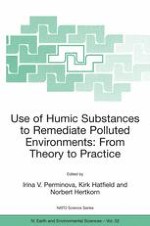Effective remediation of polluted environments is a priority in both Eastern and Western countries. In the U.S. and Europe, remediation costs generally exceed the net economic value of the land. As a result, scientists and engineers on both sides of the Atlantic have aggressively tried to develop novel technologies to meet regulatory standards at a fraction of the costs. In situ remediation shows considerable promise from both technical and economic perspectives. In situ technologies that deploy natural attenuating agents such as humic substances (HS) may be even more cost effective. Numerous studies have shown humics capable of altering both the chemical and the physical speciation of the ecotoxicants and in turn attenuate potential adverse environmental repercussions. Furthermore, the reserves of inexpensive humic materials are immense. Which suggests HS portend great promise as inexpensive amendments to mitigate the environmental impacts of ecotoxicants and as active agents in remediation. To elucidate emerging concepts of humics-based remediation technologies, we organized the NATO Advanced Research Workshop (ARW), entitled "Use of humates to remediate polluted environments: from theory to practice", held on September 23-29, 2002 in Zvenigorod, Russia (see the web-site http://www.mgumus.chem.msu.ru/arw).
